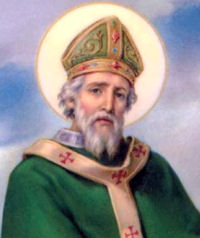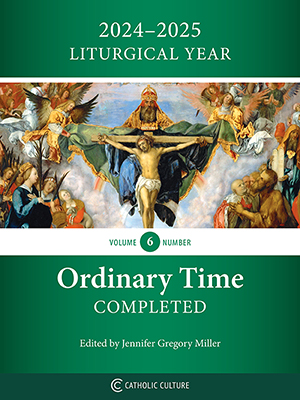Lent: March 17th
Thursday of the Second Week of Lent; Optional Memorial of St. Patrick, bishop and confessor (Solemnity Australia, Ireland, Feast New Zealand, Scotland, Wales)
» Enjoy our Liturgical Seasons series of e-books!
Entrance Antiphon, Cf. Ps 139 (138):23-24:
Test me, O God, and know my thoughts. See that my path is not wicked, and lead me in the way everlasting.
After St. Mary Major’s, St. Mary in Trastevere, rebuilt in the twelfth century, in which today’s station is held, is the most beautiful church of our Lady in Rome.
The thought expressed in today’s First Reading in Jeremias is one of the basic themes of the great prophets; it is to be found also in the Psalms (particularly Ps 1) and the book of Proverbs. Trust in men and trust in God—the former belies our expectations and only the latter assures our happiness and enables us to “bring forth good fruit.”
The parable of the rich man and Lazarus, the beggar, is addressed to the Pharisees. The rich man stands for the haughty man who, proudly satisfied with the gifts that God has bestowed on him, is unaware that living as he does he loses God’s favour. The teaching is the same as in the Epistle; blessed are the poor in spirit: those who put their trust in God. —St. Andrew Daily Missal
This day is not all about leprechauns, shamrocks and green beer. This is a day to honor and pray to St. Patrick. He was an influential saint who, 1,500 years ago, brought Christianity to the little country of Ireland. He was born about 385 in the British Isles, was carried off while still very young during a raid on Roman Britain by the Irish and sold as a slave. At the end of six years he contrived to escape to Europe, became a monk and was ordained; he then returned to Ireland to preach the Gospel. During the thirty years that his missionary labors continued he covered the Island with churches and monasteries; in 444 he founded the metropolitan see of Armagh. St. Patrick died in 461. After fifteen centuries he remains for all Irishmen the great bishop whom they venerate as their father in the Faith.
Meditation—Prayer of Confidence in the Merits and Merciful Power of Jesus
The proud who claim to draw their power form themselves, commit the sin of Lucifer, who said: “I will ascend into Heaven…. I will be like the Most High”; like Lucifer they will be overthrown and cast down into the abyss.
But what do we say? That without Christ, we can do nothing, as He has Himself declared. We declare that it is through Jesus, with Jesus, that we can arrive at holiness and enter into Heaven; we say to Christ: “Master, I am poor, miserable, naked, weak, of this I am daily more and more convinced. But I know, too, that Thou art ineffably powerful, great and good; I know that the Father Thou lovest so much hath placed in Thee all the treasures of holiness that men may desire; I know that Thou wilt never reject those who come to Thee. Therefore, whilst adoring Thee in the deepest recesses of my soul, I have full confidence in Thy merits and satisfactions; I know that, altogether miserable as I am, Thou canst, by Thy grace, shower Thy riches upon me, uplift me even to the Divine, that I may be made like unto Thee and may share in Thy Divine Beatitude!”
—Dom Columba Marmion, Christ the Ideal of the Monk
St. Patrick
Not many facts are known about the life of St. Patrick. We know that he was born around 415 AD, and was a Roman Briton. When he was about 16, while he was tending his sheep some Irish raiders captured him and made him a slave. He eventually was able to escape and return to Britain. There he heard the call to return and bring Christianity to Ireland. He was ordained a priest, consecrated a bishop and came back to Ireland around 435 AD. Many legends are associated around St. Patrick: how he drove the snakes out of Ireland, and the use of the shamrock to teach the mystery of the Trinity. Whether or not the legends are true, St. Patrick succeeded in bringing Catholicism to Ireland, and in time, the whole country converted from their pagan gods to the one true God.
Although a small country, Ireland has played a large role in saving and bringing Christianity throughout the world. During the early Dark Ages, the Irish monasteries preserved Western writings while Europe remained in darkness. But as the Catholic country remained solidly Catholic, the Irish spread the faith to all corners of the world. To learn more on this subject, read Thomas Cahill's How the Irish Saved Civilization.
We have a few works attributed to St. Patrick, one being his autobiography called Confessions. It is a short summary of the events in his life, written in true humility. Below is a short excerpt:
I am greatly God's debtor, because he granted me so much grace, that through me many people would be reborn in God, and soon after confirmed, and that clergy would be ordained everywhere for them, the masses lately come to belief, whom the Lord drew from the ends of the earth, just as he once promised through his prophets: "To you shall the nations come from the ends of the earth, and shall say, Our fathers have inherited naught hut lies, worthless things in which there is no profit." And again: "I have set you to be a light for the Gentiles that you may bring salvation to the uttermost ends of the earth."
Patronage: against fear of snakes; against ophidiophobia; against snake bites; against snakes; barbers; barrel makers; blacksmiths; cattle; coopers; engineers; excluded people; hairdressers; miners; ophidiophobics; Ireland; Nigeria (1961)
See Catholicsaints.info for the long list of different diocese that claim St. Patrick as their patron.
Symbols and Representation: A bishop trampling on snakes; bishop driving snakes away; shamrock; snakes; cross; harp; demons; baptismal font; Purgatory; serpent
Highlights and Things to Do:
- Listen to Catholic Culture's Podcasts and Audiobooks:
- Way of the Fathers by Mike Aquilina, 51—St. Patrick: Paternal and Patristic
- Audiobook read by James Majewski:
- Read more about St. Patrick:
- Honor St. Patrick by trying typical Irish fare: corned beef and cabbage, soda bread, scones, stew, Shepherd's pie, potatoes in various forms and the famous beer and spirits of Ireland. For dessert, try making the Irish Porter Cake. See Catholic Cuisine for some food ideas.
- Read the Lorica (Breastplate) of St. Patrick. Here is an older translation — pray it with your family after your rosary tonight.
- From the Catholic Culture library:
- The Conversion of Ireland by Warren Carroll
- The Irish Soldiers of Mexico by Michael Hogan
- The Irish Madonna of Hungary by Zsolt Aradi
- Our Lady in Old Irish Folklore and Hymns by James F. Cassidy
- Listen to Catholic Culture's Way of the Fathers St. Patrick: Paternal and Patristic by Mike Aquilina.
- St. Patrick's grave is unknown, but his relics are located in Down Cathedral.






